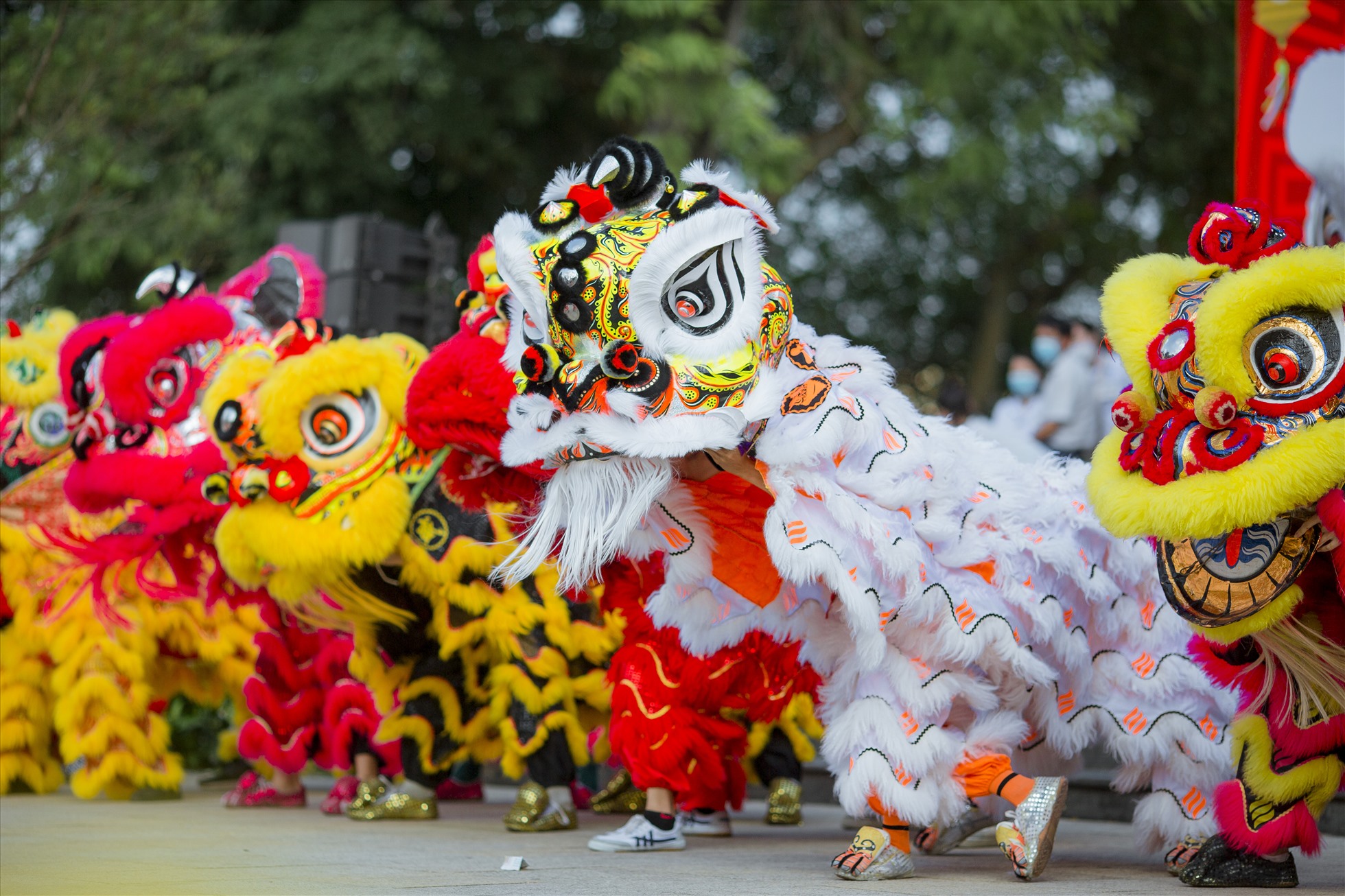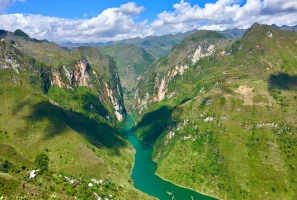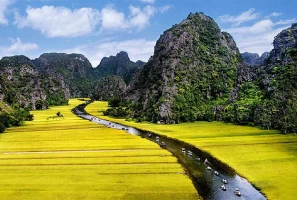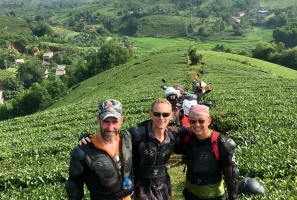Tet Trung Thu, or the Mid-Autumn Festival, is a time-honored celebration in Vietnam that brings families together to honor ancestors and marvel at the full moon. Frontier Travel aims to showcase the essence of Tet Trung Thu, allowing visitors to explore its origins, rituals, and significance in preserving Vietnam's cultural heritage.

1. What is Tet Trung Thu?
Tet Trung Thu, or the Mid-Autumn Festival, is a beloved holiday in Vietnam that falls on the 15th day of the 8th lunar month. With roots in ancient Chinese and Vietnamese traditions, this festival is a time for families to gather, give thanks for the harvest, and celebrate the full moon. The origins of Tet Trung Thu can be traced back to the worship of the Moon Goddess, who was believed to grant wishes and bring good fortune.
During Tet Trung Thu, families gather to enjoy special meals, exchange gifts, and participate in festivities. Children, the focus of this "Children's Festival," carry colorful lanterns, perform lion dances, and receive gifts like mooncakes, traditional pastries symbolizing family unity. The celebration strengthens family bonds, expresses gratitude, preserves cultural heritage, and encourages children's well-being.

2. Folk tales about the Tet Trung Thu in Vietnam
Do you know that in Vietnam, there is a fascinating folk tale behind the Mid-Autumn Festival involving three characters: Cuoi, Hang Nga, and the Jade Rabbit?
The Story of Mr. Cuoi

In Vietnamese folklore, there's a story about Cuoi, who discovered a miraculous plant that could revive the dead after a battle with a tiger. Out of compassion, Cuoi cultivated the herb to heal his sick wife and villagers. One day, his wife accidentally caused the magical tree and Cuoi to float up to the sky, where he ended up on the moon, forever tending to the tree.
Every full moon, people see a silhouette resembling an ancient tree with someone beneath it, believed to be Mr. Cuoi, waiting to return to Earth. The full moon of August symbolizes the reunion of Hang Nga and Cuoi during the Mid-Autumn Festival. Children enjoy lion dances and lantern parades, while families set up altars, admire the moon, and share a feast, celebrating unity and the magic of the festival.
The Legend of Hang Nga

Hang Nga, also known as Ms. Hang, is a legendary figure in the mythologies of China, Vietnam, and Japan. She was a woman of extraordinary beauty and the beloved wife of Hau Nghe, a hero famous for shooting down nine suns to save his people.
The legend tells that Hang Nga received an elixir of immortality from the Western Queen Mother. The elixir's power was so immense that it sent her soaring to the moon, where she now resides.
This enchanting story has given rise to the tradition of moon-gazing during the Mid-Autumn Festival. People believe that by looking at the moon, they honor Hang Nga and seek her blessings for good fortune and peace.
The Legend of the Jade Rabbit

In Vietnamese culture, there is an ancient tale of two rabbits who achieved enlightenment and went to meet the Jade Emperor. When they reached the Southern Heaven Gate, they witnessed Hang Nga being taken to the moon by the Venus Owner. Moved by her sacrifice for humanity, the elder rabbit sent the younger rabbit to the moon to keep her company.
3. Interesting activities during the Vietnamese Mid-Autumn festival
During the Vietnamese Mid-Autumn Festival, a wide array of fascinating activities take place, allowing participants to immerse themselves in the rich cultural traditions of the country. From the preparation of colorful lanterns to the lively lion dance performances, there is no shortage of engaging experiences to enjoy during this festive time.
Preparation and decoration

In the days leading up to Tet Trung Thu, families busy themselves with preparations and decorations. Houses and streets are adorned with colorful lanterns, paper cutouts, and banners bearing festive motifs. Children often help create handmade lanterns using bamboo frames and transparent paper, expressing their creativity and excitement for the upcoming celebration.
Moonlit celebrations

On the night of Tet Trung Thu, families and communities gather outdoors to bask in the glow of the full moon. Parks, riverbanks, and other open spaces come alive with people enjoying picnics, music, and each other's company. The gentle light of the moon creates a magical atmosphere, adding to the festival's enchanting ambiance and providing the perfect backdrop for shared moments of joy and togetherness.
Mooncake madness

Mooncakes, the iconic delicacy of Tet Trung Thu, are enjoyed by families and given as gifts to relatives and friends. Many families participate in the tradition of making mooncakes together, using special molds to create beautifully patterned pastries filled with various sweet and savory ingredients. Sharing mooncakes symbolizes the strengthening of relationships and the wish for a prosperous future.
Lion dance performances

Lion dance troupes take to the streets during Tet Trung Thu, putting on spectacular performances that showcase their skill, agility, and coordination. These dances, believed to bring good fortune and ward off evil spirits, are a visual feast of color and movement. The lion dancers, often accompanied by drummers and musicians, interact with the audience, collecting offerings and spreading cheer throughout the community.
Worshiping the Moon God (Đi lễ ngày rằm)

On the 15th day of the lunar month, many Vietnamese families visit temples or set up altars at home to offer prayers and offerings to the Moon God. This ritual, known as "Đi lễ ngày rằm," is an expression of gratitude for the bountiful harvest and a request for continued blessings. Offerings typically include fruits, flowers, and incense, as well as traditional dishes like mooncakes and tea.
Eating traditional Mid-Autumn specialties (Phá cỗ)

Tet Trung Thu is incomplete without the enjoyment of traditional Mid-Autumn specialties. In addition to mooncakes, families and friends gather to "phá cỗ," or feast on a variety of delectable dishes. These may include sticky rice, pomelo salad, boiled taro and sweet potato, and savory meat dishes. The shared experience of preparing and enjoying these foods strengthens familial bonds and creates lasting memories associated with the festival.
Lantern processions and riddles

As mentioned earlier, lantern processions and riddle-solving are beloved activities during Tet Trung Thu. Children showcase their beautiful lanterns as they walk through the streets, their joy and laughter filling the air. The tradition of lantern riddles encourages problem-solving skills and friendly competition, with children eagerly attempting to solve the puzzles to win prizes. This engaging activity adds an element of intellectual stimulation to the festival's celebrations.
4. Best places to celebrate Tet Trung Thu in Vietnam
Vietnam offers a wide range of enchanting destinations where visitors can experience the magic of Tet Trung Thu. From the lantern-lit streets of ancient towns to the vibrant festivities in bustling cities, each location provides a unique and memorable way to celebrate the Mid-Autumn Festival.
Hoi An

The ancient town of Hoi An transforms into a breathtaking spectacle during Tet Trung Thu. The streets are illuminated by thousands of colorful lanterns, creating a magical atmosphere that attracts visitors from around the world.
Hoi An's unique blend of Vietnamese, Chinese, and Japanese architecture provides a stunning backdrop for the festivities. Visitors can participate in lantern-making workshops, join lantern processions along the river, and savor traditional Mid-Autumn delicacies in the town's many charming cafes and restaurants.
Ho Chi Minh City

Ho Chi Minh City, as Vietnam's largest metropolis, offers a lively and varied Tet Trung Thu experience. The streets are adorned with colorful decorations, and bustling markets are filled with mooncakes, lanterns, and other festive items. Popular spots like Nguyen Hue Walking Street feature live music, lion dances, and a variety of street food. Celebrations in parks such as Tao Dan and Le Van Tam include vibrant lantern displays and cultural activities.
Ha Noi

Vietnam's capital city, Hanoi, embraces the spirit of Tet Trung Thu with its own unique charm. The city's Old Quarter is adorned with colorful lanterns and festive decorations, creating a nostalgic and picturesque atmosphere. Visitors can stroll around Hoan Kiem Lake, where they'll find locals gathering to enjoy the festivities, perform lion dances, and savor traditional snacks. The iconic Thang Long Water Puppet Theatre also puts on special Mid-Autumn performances, showcasing this ancient Vietnamese art form.
5. Tet Trung Thu around the world
Tet Trung Thu has transcended the borders of Vietnam, becoming a celebrated event in various parts of the world. Vietnamese communities abroad maintain their cultural heritage by bringing this cherished festival to life, fostering a sense of unity and belonging.
Mid-Autumn Festival in South Korea

In South Korea, the Mid-Autumn Festival is also an important day known as Chuseok, a thanksgiving day. On this day, people hold a thanksgiving ceremony to their ancestors for giving them a bountiful harvest, successful reaping, and good planting. In this country, the Mid-Autumn Festival is the second-largest holiday, and people usually take a three-day break to celebrate.
Like in Vietnam at this time, everyone gathers together, wears colorful traditional clothes, and the eldest son represents the family in offering to their ancestors. The whole family then dances and plays traditional games.
People in South Korea often visit their ancestors' graves before the Mid-Autumn Festival to remember and honor their ancestors.
Mid-Autumn Festival in China

The Mid-Autumn Festival has been celebrated for a long time in China, and Vietnam is somewhat influenced by this festival. It is considered a reunion festival, a time for Chinese families to gather and spend time together.
Like in Vietnam, during this festival, Chinese people make mooncakes that are round, symbolizing reunion and completeness. The method of making them is similar to that of Vietnamese mooncakes, with fillings such as lotus seeds, mung beans, or salted egg yolk. Additionally, lion dances are a distinctive feature that cannot be missed during the Mid-Autumn Festival in China. This is the second-largest holiday of the year, only after the Lunar New Year.
Mid-Autumn Festival in Japan

In Japan, the Mid-Autumn Festival is called Tsukimi, the moon-viewing festival, which takes place on the 15th day of the 8th month of the lunar calendar every year. The traditional Japanese treat during this time is Tsukimi Dango, small, round, white rice dumplings that are usually simply made and placed on altars to offer to the Moon.
Additionally, during the Mid-Autumn Festival, Japanese children, especially boys, are given carp-shaped lanterns by their parents to participate in lantern parades. The carp lantern symbolizes courage.
Mid-Autumn Festival in Thailand

In Thailand, the Mid-Autumn Festival is called the "Moon Prayer Festival," which takes place on the 15th day of the 8th month of the lunar calendar. On this day, everyone gathers around the altar of Quan Yin Bodhisattva and the Eight Immortals to pray for the best things for their families, the world, and even for those who have unfortunately gone astray.
Unlike other countries, the mooncakes in Thailand are shaped like peaches and are placed on the altar to worship the Eight Immortals and Quan Yin. Moreover, people often eat pomelos on this day as they symbolize completeness, reunion, sweetness, and happiness.
Mid-Autumn Festival in Myanmar

The Mid-Autumn Festival in Myanmar is also known as the Full Moon Festival or the Festival of Light. During this time, the whole country is illuminated as every house lights lanterns, making the entire nation bright and radiant. The mooncakes in Myanmar are similar to those in Vietnam and China, consisting of baked cakes with fillings like mung beans and salted egg yolk.
Mid-Autumn Festival in the Philippines

The Mid-Autumn Festival was not originally celebrated in the Philippines but was introduced by the Chinese community who came to work and live there. Despite this, the Philippines has its own unique traditions for the festival. The traditional treat eaten during this time is called Hopia. There are many varieties of Hopia, such as Hopia mungo (mung bean cake), Hopia baboy (pork cake), and Hopia ube (purple yam cake).
Mid-Autumn Festival in North Korea

The Mid-Autumn Festival in North Korea is mostly similar to that in South Korea. North Koreans also visit their ancestors' graves during the festival, but unlike South Koreans who do so before the festival, North Koreans visit the graves on the actual day of the Mid-Autumn Festival.
In conclusion, Tet Trung Thu is a cherished celebration that holds a special place in the hearts of Vietnamese people and serves as a vital link to their rich cultural heritage. With Frontier Travel Vietnam's informative guide to the festival's origins, traditions, and best places to celebrate, visitors can gain valuable insights into Vietnamese culture and create lasting memories. By participating in Tet Trung Thu celebrations, travelers not only enrich their own lives but also contribute to the preservation and promotion of Vietnam's cultural heritage.








